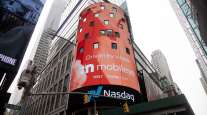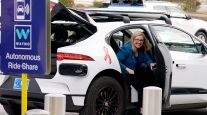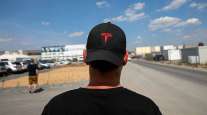Uber Unveils Second Generation Self-Driving Car in Pittsburgh
Today's adventure includes touring Uber ATG. Here's a little peek (no photos outside this area) #selfdrivinguber pic.twitter.com/G3bmsmO7K4 — Courtney Linder (@LinderPG) April 19, 2017
Uber is taking the co-driver out of its self-driving cars in Pittsburgh as the company rolls out the second generation of its autonomous Volvo SUVs.
The company announced the changes and showed off its latest car Sept. 20 as it marked the one-year anniversary of its self-driving pilot program in Pittsburgh.
“It’s like dog years, so much has happened,” Eric Meyhofer, head of Uber’s self-driving operations, said Sept. 20.
Uber invited the news media to the Pittsburgh headquarters of its Advanced Technology Group in the Strip District. A year ago, Uber had just moved into the building. It hummed with activity Sept. 20. Engineers in one room gathered around computer screens with photos and data taken from Uber trips around the city.
The building’s shop floor, shockingly still bright white a year later, was crowded with about a half-dozen Volvo XC90s having Uber’s self-driving technology installed. Racks lining the walls contained pieces and parts from the cars. The media was not allowed to photograph the shop.
In its first year, Uber’s fleet drove more than a million miles in autonomous mode in Pittsburgh, San Francisco and Tempe, Ariz., and gave more than 30,000 trips.
It's been 1 year since we launched self-driving Ubers in Steel City—here's to 1 million miles and 30,000 trips. pic.twitter.com/ayJhTAFUxx — Uber (@Uber) September 14, 2017
All those trips have been with two Uber employees in the car. One employee sat behind the wheel, driving the car when it wasn’t in autonomous mode and ready to take control of the car if needed. The other sat in the front passenger seat with a laptop monitoring what the car’s sensors and cameras saw.
Dennis Zhao, project manager for Uber’s self-driving car human experience, said removing the second employee meant moving the information displayed on the laptop to an iPad mounted on the center console and turning that iPad into a virtual driver assistant.
Pennsylvania state law requires a licensed driver to be behind the wheel of all cars, even ones equipped with self-driving technology. No laws or regulations mandate a second person in the car to monitor it.
“This was a big design project for us because we had to think about how all the communication that happens between the left seat and right seat could be distilled down to the core functionality that needed to be shown on the iPad,” Zhao said.
The iPad can alert drivers to the status of the car — manual, autonomous, ready to go autonomous — and lane changes and strange traffic patterns, like lanes suddenly becoming right-turn only.
Uber’s vehicle operators undergo a three-week training course that involves classroom work, hours on the company’s test track at the Almono development site in Hazelwood and on-street driving before they can transport passengers, said Noah Zych, head of system safety in Uber’s Advanced Technology Group. The testing simulates technology failures and trains the vehicle operators on how to respond.
RELATED: Uber Freight’s push to streamline trucking hinges on fixed rates, speedy execution
“So if they should occur on the road, they are prepared and ready to handle them,” Zych said. “These operators really take pride in the work that they do, they really understand the key role they are playing in bringing the future of transportation to life.”
Eric Klug, a vehicle operator with Uber since October, said he spends eight to nine hours behind the wheel during a 10-hour shift. He said people on the street and in passing vehicles aren’t as wowed by the self-driving Ubers as they used to be. Customers, he said, often tell him they’ve ridden in the autonomous cars several times before.
Klug gave the Tribune-Review a ride in an autonomous XC90. The SUV left the Strip District, headed into Bloomfield and then through Shadyside and Oakland before returning to Uber’s headquarters. It stayed in self-driving mode and safely navigated cyclists passing the car from behind and slowed as an on-coming car swerved into its lane. Klug popped it out of self-driving mode when he passed University of Pittsburgh police with a car pulled over, when an ambulance approached from behind with its lights and sirens on and when it didn’t look like the SUV would clear an intersection on a green light. Klug and Zych said Uber is working on anti-gridlock fixes for its technology.
Klug said the SUVs learned to navigate four-way stops several months ago. They won’t attempt Pittsburgh lefts and promptly stop when someone pulls one in front of them, Klug said.
Zych said Uber’s first million miles have allowed the company to capture unusual traffic scenarios — like unorthodox parking maneuvers on a Saturday in the Strip District, he said — and observe people dressed all sort of ways at both noon in Phoenix and sunset in Pittsburgh.
Zych said that a million miles doesn’t expose you to all that a car will face.
“The last million miles that we’ve driven has been invaluable to our developers here in this building,” Zych said. “But it’s also no secret that a million miles driven doesn’t actually tell you much about how safe our self-driving vehicles are, and this isn’t true just for Uber. This is true across all the industry.”
Zych said the next million miles will be more of the same for Uber. The company will continue to log scenarios and traffic patterns and improve its software and hardware to handle them.
Uber is committed to being transparent about the safety of its system, Zych said. It has to be because trust isn’t earned by racking up the miles but through explaining how a system works and why it’s safe.
“We have to convince ourselves that we are safe, but we also have to convince regulators and the general public that what we’re doing is trustworthy,” Zych said. “We know that it’s important for this not to just be something that we come up with but something that everybody believes is credible and safe.”
Distributed by Tribune Content Agency, LLC




